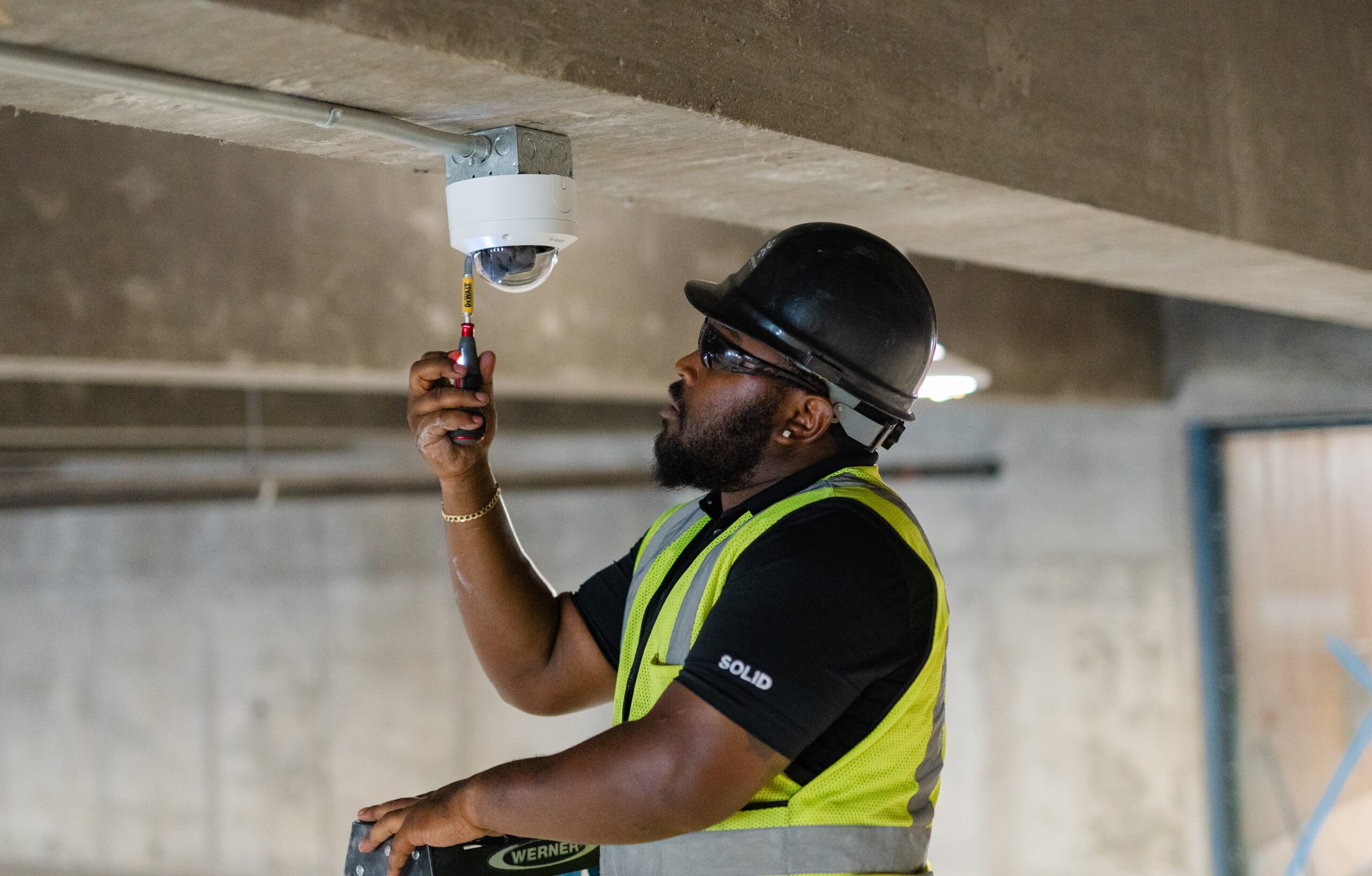
Video surveillance, commonly known as security cameras or CCTV, has seamlessly woven itself into many aspects of our everyday lives, effortlessly blending into workplaces, public spaces, and homes. By the end of 2025, the global tally of surveillance cameras is poised to surpass one billion, equating to nearly one camera for every eight individuals worldwide!
With the increasing rise in the need and popularity of video surveillance systems, comes the necessity to understand the basics of video surveillance and how to best protect your valuable people and assets. This guide empowers you with the insights needed to make informed decisions about your video surveillance infrastructure, ensuring it aligns with your specific needs and concerns.
What is Video Surveillance?
Video surveillance is the practice of monitoring a designated area using cameras to capture and record images and activities. This technology serves various purposes, including deterring criminal activities, providing evidence in legal scenarios, and improving operational efficiency.
| Video Surveillance is | Video Surveillance is not |
| – A Crime Deterrent: Acts as a preventive measure against potential criminal activities. – Security Enhancement: Elevates the overall safety and security of a given area. – Monitoring Tool: Allows for the continuous observation of a location to ensure safety and operational efficiency. – Evidence Collector: Provides visual evidence that can be used in investigations and legal proceedings. – Accessibility Enhancer: Offers remote viewing capabilities, enabling security personnel to monitor areas without being physically present. | – A Complete Security Solution: While powerful, it should be part of a comprehensive security strategy that includes other measures. – Invasion of Privacy: Properly implemented surveillance respects privacy laws and ethical guidelines. – Foolproof: Like any technology, it can be susceptible to technical issues or vulnerabilities. – Only for Crime Prevention: Beyond security, it’s used for operational monitoring, traffic flow management, and more. – Always Live-Monitored: Not all systems are monitored in real-time; some are used for recording and reviewing footage as needed. |
Understanding what video surveillance entails sets the stage for exploring the essential components that make up a robust surveillance system.
Key Components of a Video Surveillance System
A robust video surveillance system comprises several critical components, each playing a vital role in ensuring comprehensive coverage and functionality:
- Cameras: The visual capture devices, available in various types, including dome, bullet, and PTZ (Pan-Tilt-Zoom), are tailored to specific surveillance needs.
- Storage Solutions: Devices or cloud-based services where video footage is stored, allowing for playback and analysis.
- Video Management System (VMS): Software that enables the viewing, recording, and management of camera feeds.
- Networking Infrastructure: Components that facilitate the seamless transmission of video data from cameras to storage and viewing platforms.
Having outlined the key components essential for a video surveillance system, let’s delve into the different types of security cameras and how they cater to specific surveillance needs.
Types of Security Cameras
Not all cameras are created equal, and they should be selected according to your specific needs. Just like you wouldn’t use a hammer to fix a watch, relying on generic solutions for your surveillance needs can leave you blindsided. Below are three of the most common camera types and their uses.
- Bullet Cameras: Ideal for outdoor areas due to their long-range visibility.
- Dome cameras: Offer vandal resistance with their discreet design, making them suitable for sensitive areas.
- PTZ (Pan, Tilt, Zoom) Cameras: Provide remote control over movement and focus, allowing for detailed monitoring of expansive areas.
Now that we’ve covered the different types of security cameras and their specific uses, let’s focus on choosing the best surveillance cameras to meet your unique needs and maximize their effectiveness.
Selecting the Best Surveillance Cameras
There are many features surveillance cameras can offer. And depending on your needs, certain aspects will be more beneficial than others. A few key components to consider when in the market for new cameras include:
Resolution
The resolution is the number of pixels captured by a camera, which is another critical factor in the business video surveillance game. Think of it as the magnifying glass for your digital eyes. But unlike a physical tool, choosing the right “magnification” depends on your specific needs:
- High resolution (4K and above) shines where identification is crucial: Think entry points, license plates, or facial recognition. But be warned, these come with larger storage demands and higher costs.
- Lower resolution (720p) excels in wider coverage areas: Think hallways, parking lots, or general activity monitoring. While details might be fuzzier, you get more “bang for your buck” in terms of coverage.
Low-light performance
Low-light performance is another crucial aspect to consider when choosing cameras for your business’ video surveillance system. Cameras with good low-light capabilities ensure quality images under minimal lighting conditions. Low-light options include:
- Sensor size: Larger sensors capture more light, resulting in better low-light performance.
- Low-light technology: Look for features like night vision (infrared) or low-light enhancement techniques for superior visuals in darkness.
- Aperture: A wider aperture (lower f-number) allows more light to enter the lens, improving low-light performance.
- An f‑number (ƒ/#) or f‑stop refers to the ratio of a lens’s focal length to its aperture diameter and indicates the amount of light coming through the lens. Source
By choosing cameras with excellent low-light performance, you can ensure your security system truly sees the whole picture, day and night, keeping your business safe and secure.
Weatherproofing
Weatherproofing is a critical yet often overlooked aspect of choosing the right cameras for your business video surveillance system.
Why weatherproofing matters:
- Protection from the elements: Rain, snow, sleet, dust – all these can wreak havoc on un-weatherproofed cameras, leading to blurry footage, malfunctions, and ultimately, compromised security.
- Peace of mind: Knowing your cameras can withstand the elements, regardless of the season or location, brings invaluable peace of mind.
- Cost-effectiveness: Preventing weather damage saves you money in the long run compared to frequent replacements.
For outdoor surveillance, cameras must withstand various weather conditions, including rain, wind, and extreme temperatures. Ensure the cameras have a suitable IP (Ingress Protection) rating that denotes their resistance to dust and water ingress. An IP rating of IP66 or higher is recommended for outdoor use to ensure durability against harsh environmental elements.
Determining Your Surveillance Needs
We’ve provided a high-level overview of video surveillance basics. However, choosing the right system for your needs involves more than just knowing your options; it requires a clear understanding of your security requirements and objectives. Here are some key questions to consider before upgrading or installing a new surveillance system:
- Security level: What level of security do you require? Basic monitoring for peace of mind, high-resolution evidence capture, or proactive intervention with features like motion detection and analytics?
- Area coverage: How large and complex is the space you need to monitor? Multiple buildings, expansive perimeters, or specific indoor areas will influence the number and placement of cameras.
- Remote access: Do you need to view footage remotely or manage the system from afar? IP systems and cloud storage offer these capabilities, while analog systems typically require on-site access.
- Monitoring capabilities: Do you need live monitoring or primarily rely on recorded footage? Having dedicated personnel or utilizing remote monitoring services requires different considerations.
Ultimately, partnering with a security integrator is the best way to determine your surveillance needs and customize a system to fit your organization’s specific requirements. Industry experts can help you navigate the considerations outlined above, ensuring that your system aligns with your security goals, integrates seamlessly with other systems, and supports future growth.
3Sixty Integrated is a Texas-based systems integrator that specializes in the design, installation, and maintenance of electronic security technology. We partner with organizations who want to streamline their electronic security infrastructure. Additionally, as a division of The Cook & Boardman Group, 3Sixty Integrated and our sister branches have a nationwide reach and over 65 years of experience offering total opening solutions, from custom doors, frames and hardware to security integration technology. Contact us to learn how 3Sixty Integrated can help make your organization a safer place.

